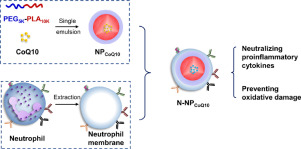当前位置:
X-MOL 学术
›
Acta Biomater.
›
论文详情
Our official English website, www.x-mol.net, welcomes your
feedback! (Note: you will need to create a separate account there.)
Neutrophil membrane-enveloped nanoparticles for the amelioration of renal ischemia-reperfusion injury in mice.
Acta Biomaterialia ( IF 9.4 ) Pub Date : 2020-01-15 , DOI: 10.1016/j.actbio.2020.01.018 Zhaohui Liu 1 , Xiangge Liu 1 , Qiang Yang 1 , Lili Yu 1 , Yulin Chang 1 , Min Qu 1
Acta Biomaterialia ( IF 9.4 ) Pub Date : 2020-01-15 , DOI: 10.1016/j.actbio.2020.01.018 Zhaohui Liu 1 , Xiangge Liu 1 , Qiang Yang 1 , Lili Yu 1 , Yulin Chang 1 , Min Qu 1
Affiliation

|
Ischemia-reperfusion (I/R) injury initiates and exacerbates a series of oxidative and inflammatory events, and causes high morbidity and mortality. Despite the progress made with recent clinical use of anti-malarial drugs, the response rate of I/R injury treatment remains unsatisfactory. Here, we showed a neutrophil membrane-enveloped Coenzyme Q (N-NPCoQ10) nanoparticle strategy for I/R injury treatment. We validated the physicochemical and biological reproducibility of the nanoparticles and tested the protective effects of N-NPCoQ10 in oxygen-glucose deprivation/reperfusion model and renal I/R injury mouse model. N-NPCoQ10 nanoparticles administration exhibited synergistic protective effect against I/R injury, which significantly reduced oxidative damage in vitro and in vivo, inhibited renal cell apoptosis, attenuated inflammatory response in renal I/R injury model, and finally improved renal function of I/R injury mice. The N-NPCoQ10 nanoparticles administration provides an efficient way to deliver anti-oxidant that suppresses oxidative damages and neutralize proinflammatory cytokines during renal I/R injury, which might be a potential strategy for renal acute kidney injury treatment. STATEMENT OF SIGNIFICANCE: The neutrophil membrane-enveloped Coenzyme Q nanoparticles (N-NPCoQ10) provides an efficient way to protect oxidative, inflammatory, and apoptotic reaction in renal I/R injury, which might be a potential strategy for renal acute kidney injury treatment.
中文翻译:

中性粒细胞膜包裹的纳米颗粒可改善小鼠肾脏缺血再灌注损伤。
缺血再灌注(I / R)损伤会引发并加剧一系列氧化和炎症事件,并导致较高的发病率和死亡率。尽管最近在抗疟疾药物的临床使用方面取得了进展,但I / R损伤治疗的反应率仍然不能令人满意。在这里,我们显示了中性粒细胞膜包裹的辅酶Q(N-NPCoQ10)纳米粒子对I / R损伤的治疗策略。我们验证了纳米颗粒的理化和生物学再现性,并测试了N-NPCoQ10在氧-葡萄糖剥夺/再灌注模型和肾I / R损伤小鼠模型中的保护作用。N-NPCoQ10纳米颗粒给药对I / R损伤具有协同保护作用,可显着降低体内和体外的氧化损伤,抑制肾细胞凋亡,减轻了肾脏I / R损伤模型的炎症反应,最终改善了I / R损伤小鼠的肾功能。N-NPCoQ10纳米颗粒的给药提供了一种有效的途径来递送抗氧化剂,该抑制剂可抑制肾脏I / R损伤期间的氧化损伤并中和促炎性细胞因子,这可能是治疗肾脏急性肾损伤的潜在策略。意义声明:中性粒细胞膜包裹的辅酶Q纳米颗粒(N-NPCoQ10)提供了一种有效的方法来保护肾脏I / R损伤中的氧化,炎症和凋亡反应,这可能是治疗肾脏急性肾损伤的潜在策略。N-NPCoQ10纳米颗粒的给药提供了一种有效的途径来递送抗氧化剂,该抑制剂可抑制肾脏I / R损伤期间的氧化损伤并中和促炎性细胞因子,这可能是治疗肾脏急性肾损伤的潜在策略。意义声明:中性粒细胞膜包裹的辅酶Q纳米颗粒(N-NPCoQ10)提供了一种有效的方法来保护肾脏I / R损伤中的氧化,炎症和凋亡反应,这可能是治疗肾脏急性肾损伤的潜在策略。N-NPCoQ10纳米颗粒的给药提供了一种有效的途径来递送抗氧化剂,该抑制剂可抑制肾脏I / R损伤期间的氧化损伤并中和促炎性细胞因子,这可能是治疗肾脏急性肾损伤的潜在策略。意义声明:中性粒细胞膜包裹的辅酶Q纳米颗粒(N-NPCoQ10)提供了一种有效的方法来保护肾脏I / R损伤中的氧化,炎症和凋亡反应,这可能是治疗肾脏急性肾损伤的潜在策略。
更新日期:2020-01-16
中文翻译:

中性粒细胞膜包裹的纳米颗粒可改善小鼠肾脏缺血再灌注损伤。
缺血再灌注(I / R)损伤会引发并加剧一系列氧化和炎症事件,并导致较高的发病率和死亡率。尽管最近在抗疟疾药物的临床使用方面取得了进展,但I / R损伤治疗的反应率仍然不能令人满意。在这里,我们显示了中性粒细胞膜包裹的辅酶Q(N-NPCoQ10)纳米粒子对I / R损伤的治疗策略。我们验证了纳米颗粒的理化和生物学再现性,并测试了N-NPCoQ10在氧-葡萄糖剥夺/再灌注模型和肾I / R损伤小鼠模型中的保护作用。N-NPCoQ10纳米颗粒给药对I / R损伤具有协同保护作用,可显着降低体内和体外的氧化损伤,抑制肾细胞凋亡,减轻了肾脏I / R损伤模型的炎症反应,最终改善了I / R损伤小鼠的肾功能。N-NPCoQ10纳米颗粒的给药提供了一种有效的途径来递送抗氧化剂,该抑制剂可抑制肾脏I / R损伤期间的氧化损伤并中和促炎性细胞因子,这可能是治疗肾脏急性肾损伤的潜在策略。意义声明:中性粒细胞膜包裹的辅酶Q纳米颗粒(N-NPCoQ10)提供了一种有效的方法来保护肾脏I / R损伤中的氧化,炎症和凋亡反应,这可能是治疗肾脏急性肾损伤的潜在策略。N-NPCoQ10纳米颗粒的给药提供了一种有效的途径来递送抗氧化剂,该抑制剂可抑制肾脏I / R损伤期间的氧化损伤并中和促炎性细胞因子,这可能是治疗肾脏急性肾损伤的潜在策略。意义声明:中性粒细胞膜包裹的辅酶Q纳米颗粒(N-NPCoQ10)提供了一种有效的方法来保护肾脏I / R损伤中的氧化,炎症和凋亡反应,这可能是治疗肾脏急性肾损伤的潜在策略。N-NPCoQ10纳米颗粒的给药提供了一种有效的途径来递送抗氧化剂,该抑制剂可抑制肾脏I / R损伤期间的氧化损伤并中和促炎性细胞因子,这可能是治疗肾脏急性肾损伤的潜在策略。意义声明:中性粒细胞膜包裹的辅酶Q纳米颗粒(N-NPCoQ10)提供了一种有效的方法来保护肾脏I / R损伤中的氧化,炎症和凋亡反应,这可能是治疗肾脏急性肾损伤的潜在策略。











































 京公网安备 11010802027423号
京公网安备 11010802027423号